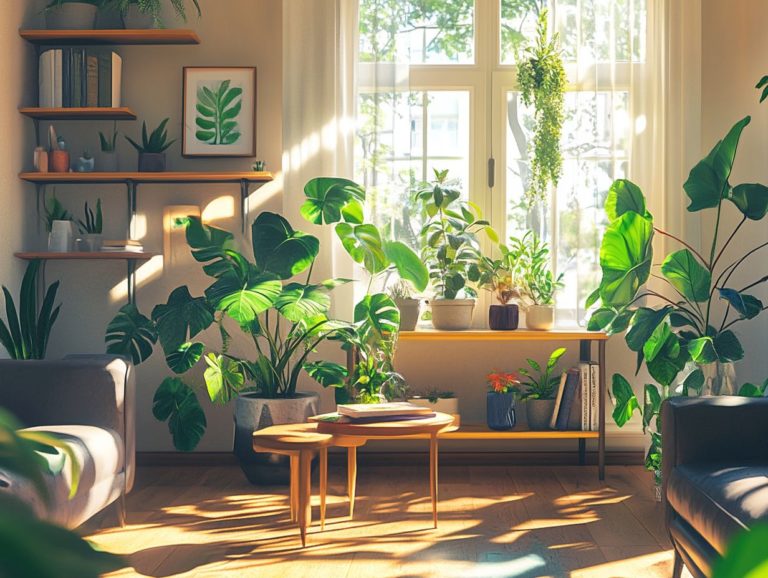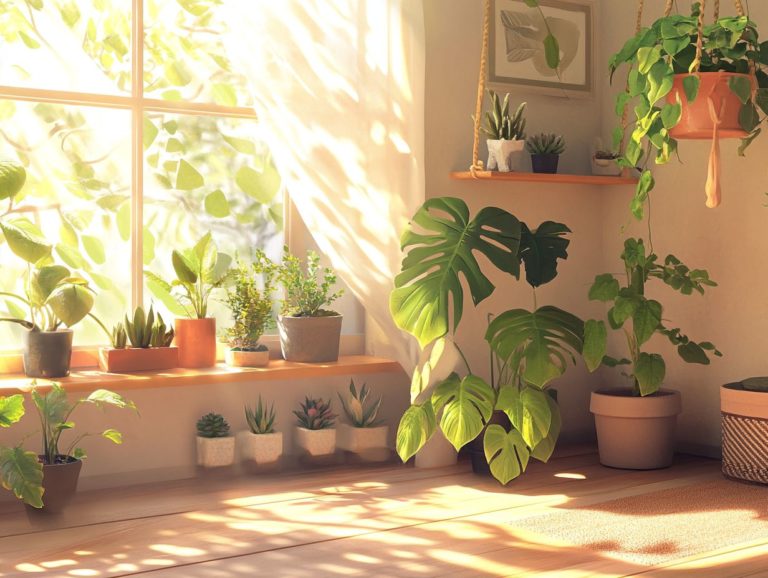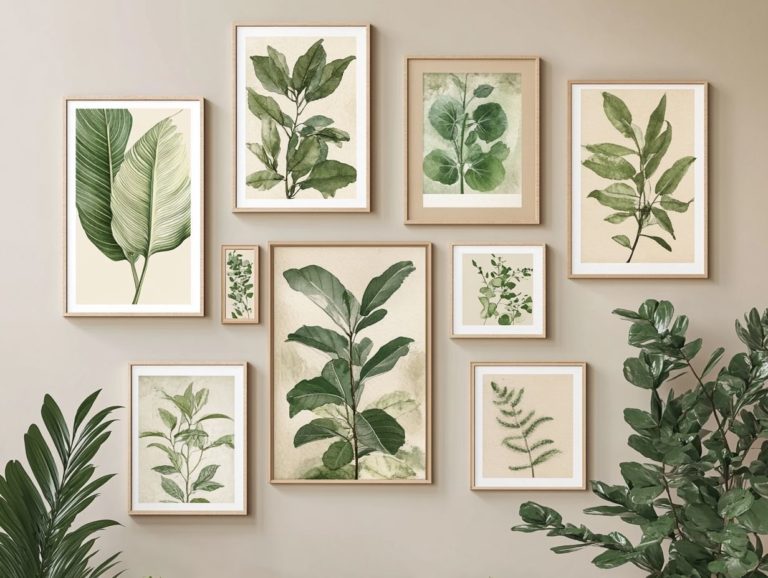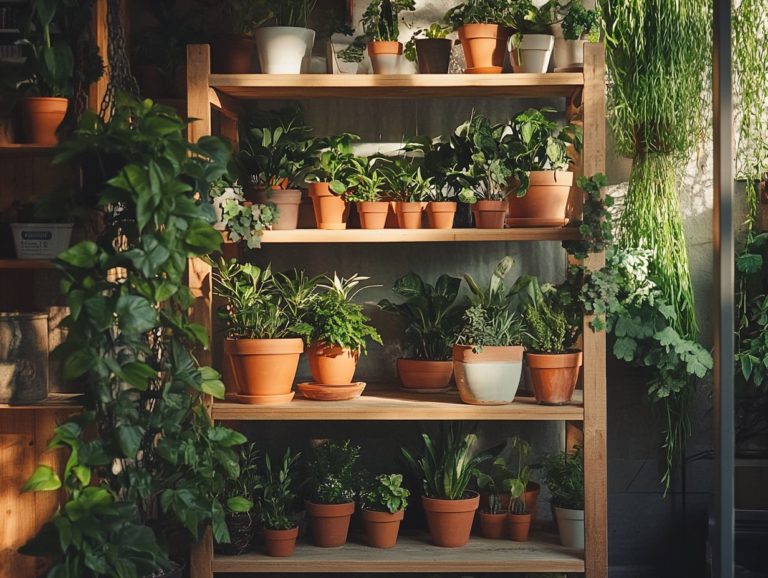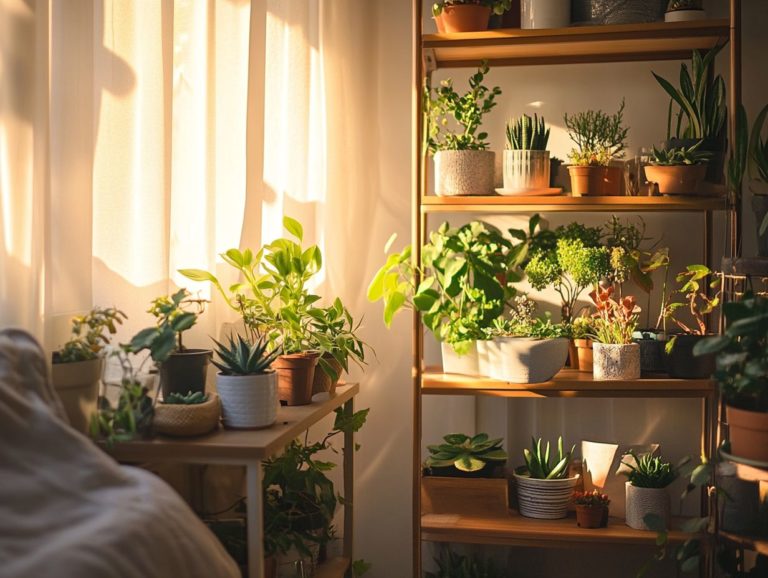Indoor Plants That Work Well in Bathrooms
Transforming your bathroom into a serene oasis can be as effortless as incorporating some lush greenery.
While not every plant will thrive in the high humidity and low light typical of bathrooms, you ll find that there are 15 indoor plants perfectly suited to these conditions, ready to elevate your bathroom’s ambiance.
From the soothing Aloe Vera to the elegant Orchids, these plants don t just beautify your space; they also enhance air quality and invite nature in.
Explore the best placement strategies, discover maintenance tips, and learn why each of these plants is an ideal choice for your sanctuary.
Contents
- Key Takeaways:
- 1. Aloe Vera
- 2. Bamboo
- 3. Begonia
- 4. Boston Fern
- 5. Chinese Evergreen
- 6. English Ivy
- 7. Orchids
- 8. Peace Lily
- 9. Philodendron
- 10. Snake Plant
- 11. Spider Plant
- 12. ZZ Plant
- 13. Pothos
- 14. Tillandsia
- 15. Air Plants
- What Makes These Plants Ideal for Bathrooms?
- How Do These Plants Help Improve Indoor Air Quality?
- What Are the Best Placement Options for These Plants in Bathrooms?
- How Do These Plants Thrive in High Humidity Environments?
- What Are the Maintenance Requirements for These Plants?
- Frequently Asked Questions
- What are the best types of indoor plants that work well in bathrooms?
- Why do these plants work well in bathrooms?
- Do these plants require a lot of sunlight?
- Do these plants help purify the air in bathrooms?
- How often should I water these plants?
- Are there any other benefits to having indoor plants in bathrooms?
Key Takeaways:
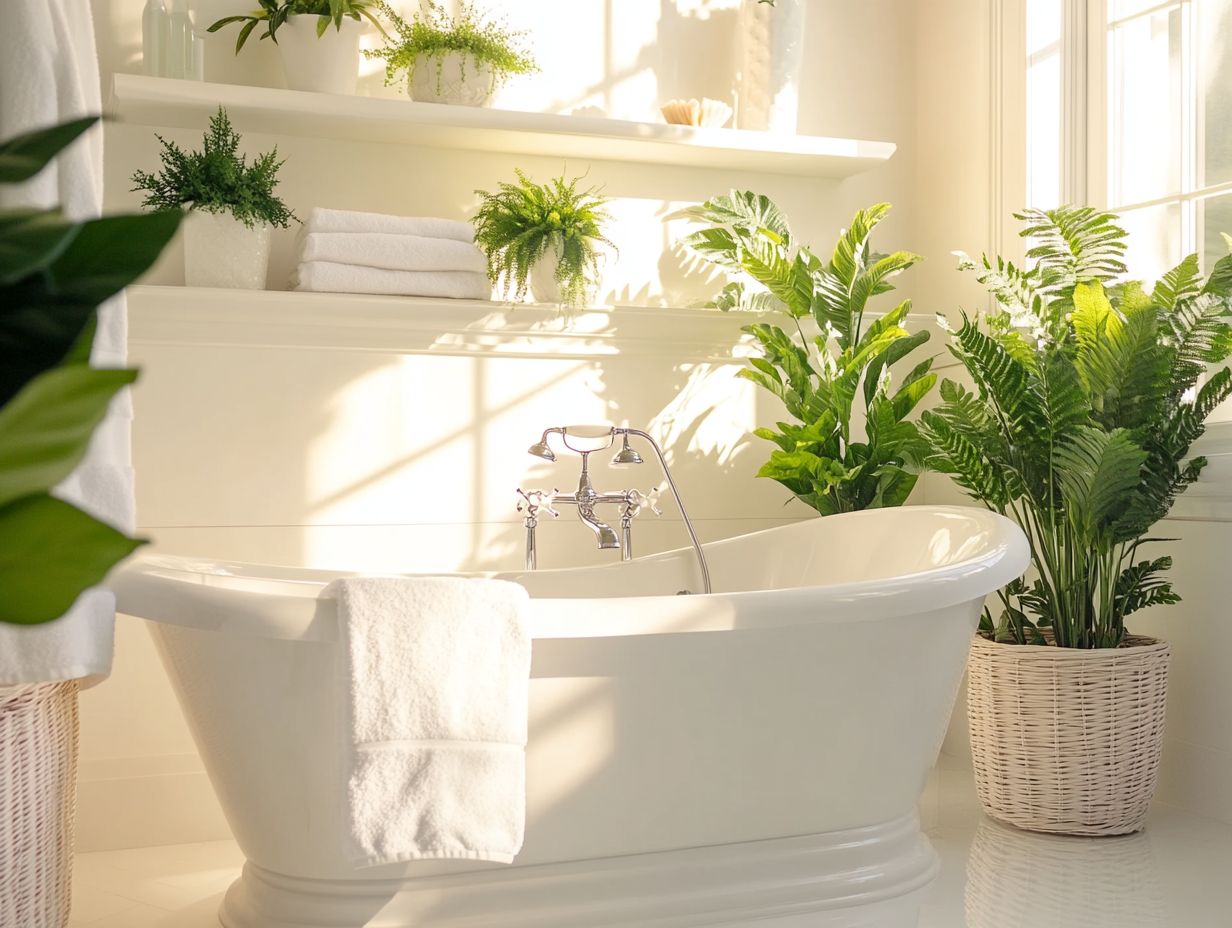
- Aloe Vera, Bamboo, and Begonia are among the top indoor plants that can thrive in high humidity environments like bathrooms.
- These plants not only add aesthetic appeal to the bathroom, but also help improve indoor air quality by filtering out pollutants and releasing oxygen.
- The best placement options for these plants are in well-lit areas such as windowsills or shelves, and they require minimal maintenance, like regular watering and occasional pruning.
1. Aloe Vera
Aloe Vera is celebrated for its medicinal properties and striking succulent leaves. It truly is one of the best low-maintenance houseplants you could choose.
This hardy succulent adds beauty to your space and enhances indoor air quality, which is essential for a healthy living environment.
To keep your Aloe Vera thriving, provide it with well-draining soil and water it regularly, but not too much. This careful approach ensures the plant stays healthy without the risk of becoming waterlogged.
Aloe Vera thrives in high humidity and can flourish in indirect light. Its air-purifying qualities help eliminate toxins from the air, creating a fresher atmosphere.
If you re in search of a resilient plant that enhances both your decor and well-being, Aloe Vera is a fantastic choice that you ll love!
2. Bamboo
Bamboo is known for its graceful growth and remarkable adaptability. It thrives particularly well in areas filled with indirect light and high humidity, making it an exquisite addition to your home decor.
Among the various types of bamboo, lucky bamboo shines as a favorite. It’s not only easy to care for, but can also flourish in water, offering a serene, minimalist vibe.
Then there’s the bamboo palm, which excels at purifying the air. It filters out toxins while producing oxygen.
These plants thrive with consistent yet moderate watering. They revel in humid environments perfect for kitchens and bathrooms alike.
Their versatility and low-maintenance nature allow them to blend seamlessly with various interior styles, enhancing your living space with both beauty and health benefits.
3. Begonia
Begonias are among the most vibrant houseplants available. They thrive in low light conditions, making them a perfect choice for your indoor garden where humidity levels may fluctuate.
With a variety of types, including Rex, Angel Wing, and Wax Begonias, each showcases unique foliage and blooms that can elevate your d cor.
Care requirements may differ slightly, but generally, these plants prefer well-draining soil and should be watered when the top inch feels dry. This keeps them from becoming waterlogged.
Begonias particularly favor high humidity, flourishing beautifully in bathrooms where the moisture in the air supports their growth.
Not only do begonias enhance your interiors, but they also contribute to improved air quality, making them a charming and beneficial addition to your home.
Start your indoor garden today and enjoy the beauty and health benefits these plants bring!
4. Boston Fern
The Boston Fern has a lush, tropical vibe that makes it one of the best indoor plants for bathrooms. It thrives in high humidity and requires minimal care, making it a perfect addition for anyone eager to elevate their indoor greenery.
This adaptable fern flourishes in indirect light, fitting seamlessly into shaded corners or spots with filtered sunlight (light softened by sheer curtains). One standout feature is its ability to purify indoor air by absorbing toxins and releasing oxygen, helping to create a healthier living space.
To keep it vibrant, maintain moist soil and mist its fronds regularly to mimic the humidity of its natural habitat. With the right attention, this resilient plant can thrive in various indoor settings, infusing your home with nature and enhancing its ambiance.
5. Chinese Evergreen
The Chinese Evergreen is the perfect low-maintenance houseplant, thriving well in indirect light. It s an excellent choice for indoor spaces where lighting conditions fluctuate, all while adding a refreshing touch of lush greenery.
This resilient plant also enhances the aesthetics of any room and boasts impressive air-purifying qualities by filtering out harmful toxins and improving indoor air quality. Its adaptability to various humidity levels means it can flourish in diverse environments, whether cozy home or busy office.
For optimal growth, remember to water it moderately and let the top inch of soil dry out between waterings. A little regular dusting of its broad leaves will keep it looking vibrant, making the Chinese Evergreen a lush and easy-going companion that brightens any setting.
6. English Ivy
English Ivy is a true gem, renowned for its enchanting vines and remarkable adaptability. It’s one of the best plants for enhancing indoor air quality, whether you’re dealing with fluctuating humidity levels or simply looking to beautify your space.
This resilient plant has a delightful climbing nature, allowing it to cascade down shelves or ascend trellises, creating a lush retreat in your home. English Ivy thrives in various indoor settings, from bright, indirect light to cozy, shaded corners, making it a perfect fit for any room.
Not only does this plant serve as a natural air purifier by efficiently removing airborne toxins, but it also fosters a healthier living environment. As it grows, it enhances the aesthetic appeal of your space, contributing to a serene atmosphere throughout your home.
7. Orchids
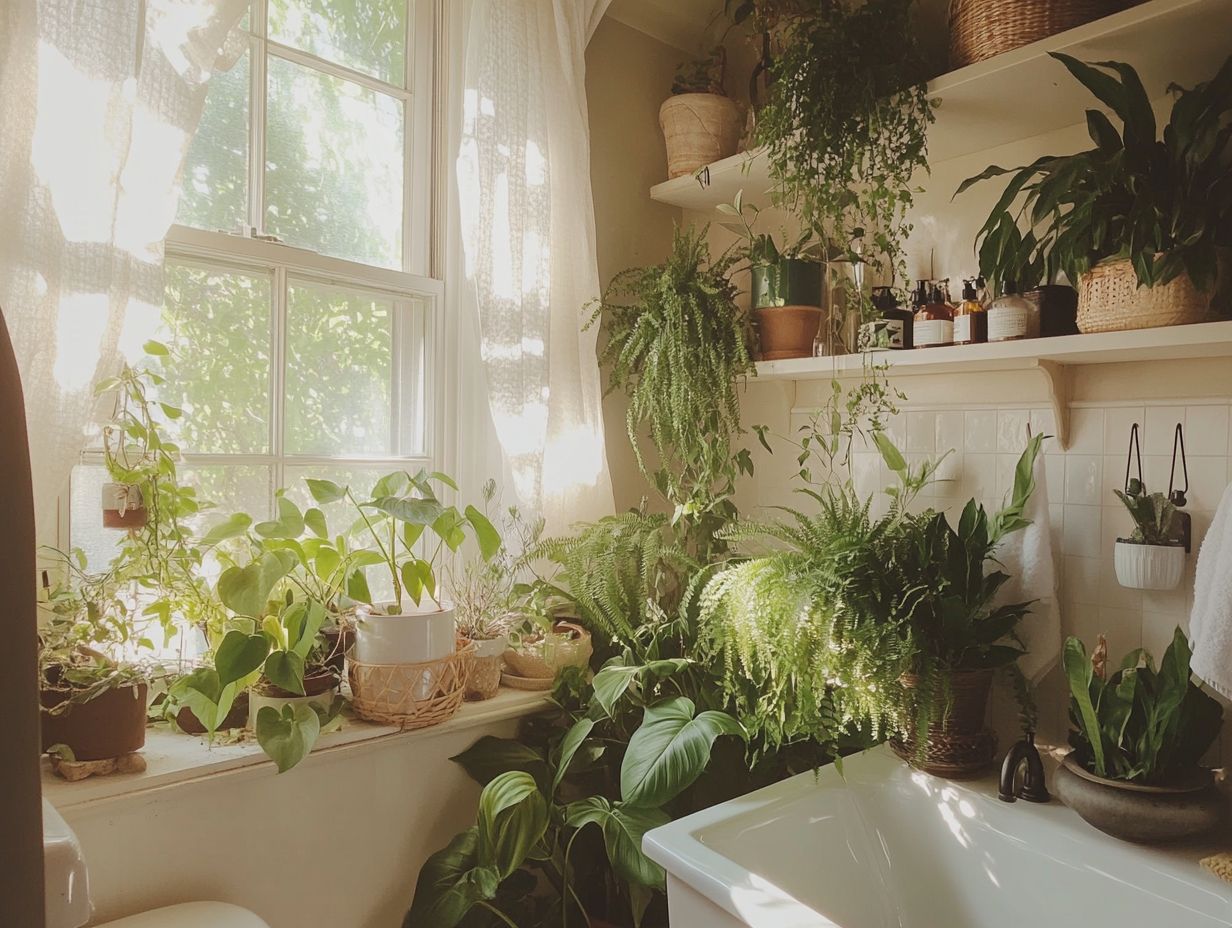
Orchids are the epitome of exotic houseplants, flourishing in high humidity while adapting well to low light conditions. They re a stunning yet manageable choice for anyone looking to infuse a touch of sophistication into indoor spaces.
You ll love the dazzling array of colors and shapes these enchanting plants offer, each requiring specific care to thrive. For example, Phalaenopsis orchids enjoy a humid environment ranging from 50-70%, while Cattleya orchids prefer slightly drier conditions. Maintaining the right moisture levels and ensuring good air circulation is crucial.
To coax out breathtaking blooms, establish a regular feeding routine with a balanced fertilizer. Don t forget to introduce a temperature change now and then it can work wonders.
The aesthetic charm of these elegant flowers not only elevates the beauty of your interiors but also improves air quality, making them a delightful addition to any home. Don’t miss out on the chance to bring these beautiful plants into your home today!
8. Peace Lily
The Peace Lily is famous for its stunning white blooms. It’s a fantastic choice for indoor spaces, especially in humid environments!
This plant thrives in low light, making it perfect for dim rooms or bathrooms. Remember to water it when the top inch of soil feels dry!
One of its unique features is its air-purifying abilities. It filters out harmful toxins like ammonia and formaldehyde, making your living space healthier!
9. Philodendron
If you’re looking for low-maintenance greenery, the Philodendron is your go-to houseplant! It thrives effortlessly in indirect light.
With its lush foliage, it adds a touch of tropical elegance to any indoor setting. This genus includes numerous species, each with unique shapes and sizes.
From the beloved Heartleaf to the striking Jungle Boogie, you’ll find the perfect fit for your space. Caring for these hardy plants is easy they prefer well-draining soil and moderate watering.
What’s fascinating is how adaptable they are to varying humidity levels. They re ideal for urban homes with lower moisture or more humid climates!
Not only do these plants beautify your space, but they also act as natural air purifiers. They enhance indoor air quality by filtering out harmful toxins and creating a refreshing environment!
10. Snake Plant
The Snake Plant, also known as Sansevieria trifasciata, is a strong and hardy houseplant. It thrives in low light and adapts to various humidity levels!
This versatile plant blends effortlessly into any indoor setting, whether in a cozy apartment or a bustling office.
When caring for your Snake Plant, avoid overwatering. This succulent likes its soil to dry out between waterings!
Watering it once every couple of weeks is usually enough, but feel free to adjust based on light conditions and temperature changes.
Not only is the Snake Plant low-maintenance, but it also excels in air purification. It filters out toxins, improving your indoor air quality!
11. Spider Plant
The Spider Plant, or Chlorophytum comosum, is an exceptional houseplant that flourishes in humidity-rich environments like bathrooms. It thrives in low light conditions too!
This versatility makes it a splendid addition to your indoor space. Caring for it is easy it requires only occasional watering and indirect sunlight!
Renowned for easy propagation, the Spider Plant produces delightful pups you can re-pot. This allows even novice gardeners to expand their collection!
Beyond its low-maintenance appeal, the Spider Plant significantly enhances indoor air quality. It filters harmful pollutants, which is invaluable in today s urban landscapes!
Its lush green foliage and elegantly arching leaves add aesthetic charm, brightening up any room, whether in modern apartments or cozy homes!
12. ZZ Plant
The ZZ Plant, scientifically known as Zamioculcas zamiifolia, is your ticket to a stunning indoor garden without the fuss! This remarkably low-maintenance houseplant thrives in low light and can handle varying humidity levels.
Its ability to tolerate neglect is impressive. You can water it infrequently and still enjoy its vibrant presence!
With its waxy, dark green leaves, the ZZ Plant not only enhances your space’s aesthetic but also acts as an air purifier. It filters out harmful toxins and improves your indoor air quality!
This versatile plant fits seamlessly into any interior whether in your office, living room, or a minimalist nook. If you’re seeking to elevate your indoor atmosphere with minimal effort, this hardy companion is the perfect addition!
Ready to bring some greenery into your life? Start with these easy-to-care plants today!
13. Pothos
Pothos is a standout choice for indoor spaces. It thrives in low light and loves humidity, making it perfect for bathrooms and cozy rooms.
This resilient plant has trailing vines that can grow several feet long. You can train them to climb or let them cascade, matching your style.
Pothos elevates your indoor aesthetic and purifies the air by filtering out harmful toxins. Caring for pothos is simple: just water it when the top inch of soil feels dry.
Overwatering can cause root rot, which is when the roots decay from too much water. Its adaptability means it grows well with minimal maintenance, offering beauty and health benefits in various indoor settings.
14. Tillandsia

Tillandsia, known as air plants, are a unique choice for anyone wanting greenery without the fuss of soil. These low-maintenance wonders thrive in high humidity, perfect for imaginative displays.
With various species, each having distinct leaf shapes and colors, you can find the perfect match for your decor. From the delicate Tillandsia ionantha to the striking Tillandsia xerographica, options abound.
Most air plants prefer bright, indirect light and appreciate misting or soaking to stay hydrated. You can easily incorporate them into your spaces, whether on a windowsill or in a vibrant terrarium.
To elevate your home decor, use driftwood, wall-mounted holders, or hanging glass orbs. Showcase their beauty and transform any room into a living work of art.
15. Air Plants
Air plants, or Tillandsia, let you add greenery without the fuss of traditional soil. They thrive in high humidity and require minimal maintenance, making them a stylish addition to any decor.
Each species has unique characteristics. The Tillandsia ionantha showcases vibrant colors and blooms, while the Tillandsia xerographica captivates with its stunning rosette shape.
Most prefer bright, indirect light and need misting or soaking every one to two weeks. Their versatility opens up creative display options hang them in terrariums or arrange them in decorative bowls.
With such low upkeep, air plants elevate any indoor space, offering a refreshing touch of nature that enhances your surroundings beautifully.
What Makes These Plants Ideal for Bathrooms?
The best bathroom plants thrive in high-humidity environments. They enhance air quality and make your space feel refreshing.
These plants flourish in the warm, moist conditions typical of bathrooms. They also purify the air by filtering out common toxins. Snake plants and peace lilies thrive in this damp setting and improve your air quality.
Many resilient plants adapt beautifully to kitchens or living rooms. Their ability to tolerate varying light conditions makes them versatile additions to any home.
How Do These Plants Help Improve Indoor Air Quality?
These plants play a crucial role in enhancing indoor air quality by filtering out toxins and releasing oxygen. They are not just a treat for the eyes; they are also a boon for your health.
Among the myriad of options, the Peace Lily truly shines. It effectively removes harmful substances like formaldehyde and benzene from the air. The Spider Plant is another excellent option, excelling at banishing carbon monoxide and other pollutants.
The secret to their impressive purifying abilities lies in their special parts. These parts efficiently absorb chemicals through their leaves and roots, breaking them down in the process.
To enjoy these benefits, provide proper care. Keep your plants thriving by actively checking for pests, ensuring adequate watering, and offering sufficient light. This way, the lush greenery can thrive and help you cultivate a healthier atmosphere.
What Are the Best Placement Options for These Plants in Bathrooms?
When considering the best placement options for bathroom plants, think about factors like humidity levels and available light. Choosing spots that enhance these conditions can significantly boost their growth.
For instance, placing a plant near an east-facing window allows it to soak up the gentle morning sunlight that many species, like ferns, love. Conversely, for plants that prefer lower light, position them further back in the room or near a north-facing window. Being close to moisture sources like the shower or sink creates a humid microclimate, perfect for tropical plants. If you’re looking for specific options, check out what indoor plants are best for bathrooms.
To truly optimize their growth potential, regularly check the soil moisture and adjust your watering routines based on humidity levels. This attention ensures vibrant, flourishing greenery in what is often an overlooked space.
How Do These Plants Thrive in High Humidity Environments?
Plants that flourish in high humidity environments possess remarkable adaptations that enable them to absorb moisture efficiently. This makes them excellent choices for indoor spaces, especially in bathrooms where humidity is a constant companion.
Take the Boston Fern (Nephrolepis exaltata), for example. Its finely divided fronds increase the surface area for evaporation, enhancing its ability to soak up moisture from the air. The Peace Lily (Spathiphyllum) boasts lush, broad leaves that not only drink in water but also purify your indoor air. For more options, check out the top 5 indoor plants for humid spaces.
These adaptations are vital for the plants survival and significantly contribute to a healthier indoor atmosphere. By creating an environment that mimics their natural high humidity habitat, you can significantly boost their growth and vibrancy, ultimately leading to lush greenery that thrives beautifully in your home.
What Are the Maintenance Requirements for These Plants?
The maintenance requirements for these plants can vary, but many fall into the low-maintenance category, making them perfect for anyone eager to elevate their indoor spaces with greenery without extensive plant care.
Take succulents and snake plants (Sansevieria trifasciata), for example. They flourish in bright, indirect light and require minimal watering just when the soil is completely dry. The Peace Lily needs a bit more attention; it thrives in low to medium light and requires consistent moisture to keep its soil damp.
Understanding these specific needs is crucial. It keeps your plants healthy and contributes to a more vibrant home environment. By utilizing well-draining soil and appropriate pots, you can further enhance growth, especially for plants like fiddle leaf figs (Ficus elastica), which appreciate a touch more humidity and a deliberate watering routine.
Frequently Asked Questions
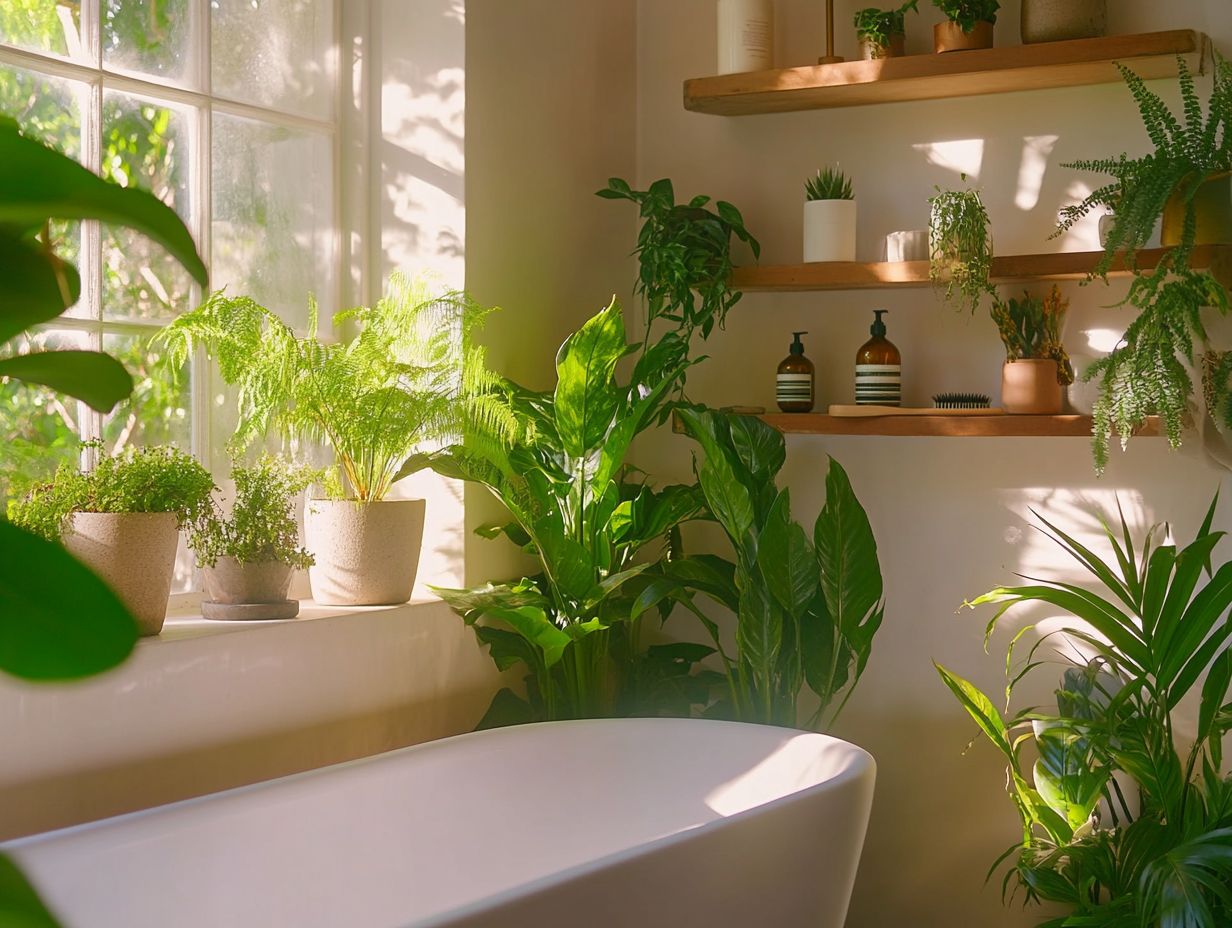
Explore these plants today, and transform your indoor spaces into vibrant, healthy environments!
What are the best types of indoor plants that work well in bathrooms?
Some of the best options for indoor plants that thrive in bathrooms include ferns, spider plants, peace lilies, and snake plants. Plants like Elephant ears and Philodendron xanadu also thrive in this environment.
Why do these plants work well in bathrooms?
These plants thrive in bathrooms. They love humidity in the air. Bathrooms are often more humid due to the frequent use of hot water.
Do these plants require a lot of sunlight?
No, most of these plants can grow well in low light. They thrive in indirect light, making them perfect for bathrooms with small or no windows.
Do these plants help purify the air in bathrooms?
Yes, many of these plants can remove toxins and pollutants from the air. This helps create a healthier and more pleasant environment in your bathroom.
How often should I water these plants?
Keep your plants happy by watering them regularly. Aim to water them once a week or whenever the top inch of soil feels dry.
Are there any other benefits to having indoor plants in bathrooms?
Yes! Besides their beauty and air-purifying qualities, indoor plants help reduce mold and mildew growth. They absorb excess moisture, making it less hospitable for these unwanted issues.

